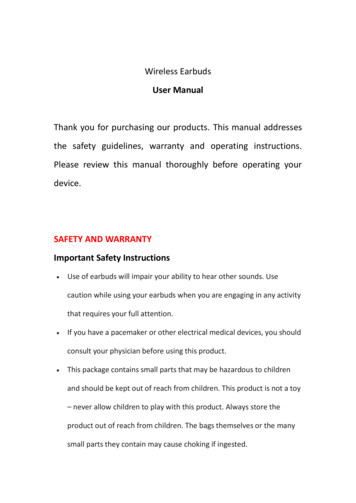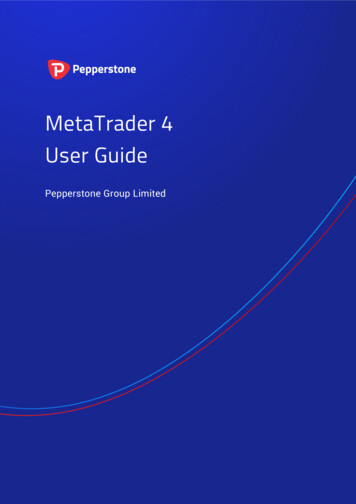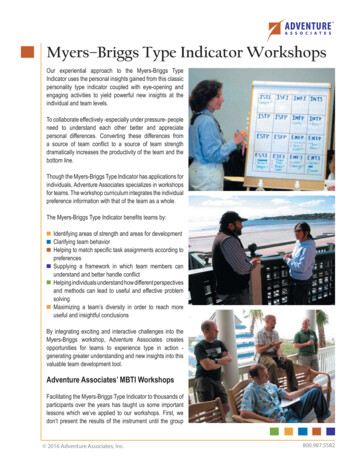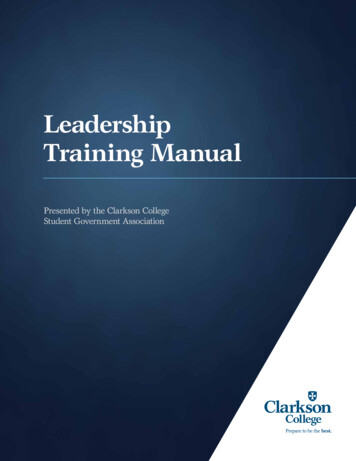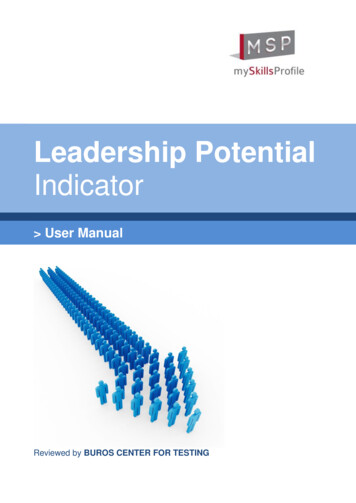
Transcription
Leadership PotentialIndicator User ManualReviewed by BUROS CENTER FOR TESTING
Copyright 2017 MySkillsProfile.com Limited.www.myskillsprofile.comLPI is a trademark of MySkillsProfile.com Limited.All rights reserved. No part of this publication may be reproduced or distributed in any form or by any meansor stored in a database or retrieval system without the prior written permission of MySkillsProfile.comLimited.
Contents1. Introduction . 21.1 Purpose of LPI . 21.2 LPI Competency Model . 21.3 LPI Development . 32. Administration . 102.1 Applications . 102.2 Test Administration . 102.3 Norming . 113. Scale Descriptions . 123.1 Overview . 123.2 Sten Scale . 123.3 How to Interpret Scores . 134. Norms . 354.1 International Comparison Group . 354.2 Norms Table . 375. Reliability and Validity . 395.1 Reliability . 395.2 Standard Error of Measurement . 405.3 Validity . 406. Group Comparisons . 506.1 Gender . 506.2 Age . 516.3 Ethnic Origin . 516.4 Nationality. 52References . 55LPI User Manual 1
1. Introduction1.1 Purpose of LPIThe Leadership Potential Indicator (LPI) is designed to help individuals in management andleadership positions identify their current areas of competency, and decide where theyshould focus their development efforts. This manual describes the LPI competencyassessment approach and the design and development of the instrument.1.2 LPI Competency ModelThe LPI leadership assessment test was designed around a five-factor concept model ofmanagement and leadership competencies: Managing Change, Planning and Organizing,Interpersonal Skills, Results Orientation, and Leadership (Figure 1).Figure 1. LPI Concept Model of Management and Leadership CompetenciesManagingChangePlanning ionInterpersonalSkillsLPI User Manual 2
1.3 LPI DevelopmentThe development and production of the LPI can be broken down into three broad workstreams.Phase 1. In the first phase of development, we carried out a literature review and contentanalysis of models and measures of management and leadership competencies, anddeveloped a five-branch model of management and leadership competencies. We thendeveloped, piloted, and published a 20-scale instrument based on this five-branch model.The first commercial version of the assessment was published as a paper and pencil test in1998.Phase 2. In 2004, we carried out an evaluation of the instrument which led to the publicationof the second version of the instrument with a revised user manual and a new computergenerated feedback report. We made changes to some of the scales to improve theirreliability, and we published new norms based on a much larger international comparisongroup. The revised user manual provided a more detailed picture of the psychometricproperties of the instrument.Phase 3. In 2014, we carried out a second evaluation of the LPI in preparation for submittingthe test for review. The objective was to ensure that the measure was ready, and the testdocumentation was in a suitable format for review by the British Psychological Society andBuros Center for Testing. We did further research on the construct validity of the measureduring this phase, and updated the user manual.Design standards. The LPI leadership assessment test is designed to meet the key criteriain the EFPA Review Model for the Description and Evaluation of Psychological Tests(Bartram, 2002). The EFPA Review Model was produced to support and encourage theprocess of harmonizing the reviewing of tests. It provides a standard set of criteria to assessthe quality of modern psychometric tests. These cover the common areas of test reviewsuch as norms, reliability, and validity.Competencies. McClelland (1973) is generally credited with using the term "competencies"to refer to factors that could predict job success. He defined competency as an underlyingcharacteristic--an ability to do something--producing effective or superior performance. TheLPI competency framework was based on a concept model of management and leadershipcompetencies modelled on Boyatzis’ (1982) approach illustrated below. A wide-rangingliterature search was carried out to identify competency dimensions related to successfulmanagement and leadership tencyUse of oral presentationsSkillsVerbal presentation skillsCompetency dimensions identified during the literature search were printed on cards. Theresulting cards were sorted into groups, and each group was given a broad title--forexample, "quality/detail orientation". The list of competency groups that emerged from thisprocess was compared with a list of frequently occurring competencies reported in a surveyof company competency frameworks, and twenty competencies were selected (Table 1).LPI User Manual 3
Table1. LPI Management and Leadership CompetenciesScale DefinitionInitiating activityShows initiative, has positive attitude, self-starterTaking risksCreating and innovatingAdapting to changeAnalyzing and interpretingPlanning and prioritizingPlans and prioritizes tasks, project manages work effectivelyMonitoring qualityTakes pride in work, does job well, gets the detail correctListening and supportingCommunicates views and ideas assertively, makes impact withpresentationsDisplays sensitivity to people’s needs, involves people in plans anddecisionsDevelops strong working relationships, builds rapport quicklyTeam workingStrong team player, works effectively with peopleAchieving goalsSelf-motivated, driven to get ahead, prepared to do whatever ittakesMeeting customer needsApplies customer concepts, focuses on quality and serviceFocusing on the businessLearning and developingPersuading and influencingCoaching othersCoping with pressureLeadershipMotivating and empoweringUnderstands the business, focuses on bottom line, keeps eye oncompetitorsExploits opportunities for self-development, demonstrates selfawarenessHas presence and authority, enjoys being in charge, takes leadwhen requiredEmpowers and motivates team members, delegates taskseffectivelyCoaches and mentors team members, gives regular developmentfeedbackResults OrientationRelating and networkingInterpersonal SkillsCommunicatingPlanning andOrganizingMaking decisionsTakes risks, challenges accepted practice, bends rules to makeprogressOriginates change, makes things better, produces creative ideasand solutionsAdapts quickly to change, responds flexibly to people andsituationsAnalyses situations carefully, makes rational judgments and logicaldecisionsDecides quickly, displays confidence, acts independently whennecessaryManaging ChangeScaleHandles pressure and stress, stays calm and in controlTable 2 shows some of the frequently occurring competencies in company competencyframeworks identified by the 1996 survey (HR-BC/IRS, 1996) which the LPI measures.LPI User Manual 4
Table 2. Top 10 Competencies in Organization s-orientation28Customer focus22Teamwork22Leadership17Planning and organizing17Commercial awareness16Developing others15Analytical thinking12Building relationships12In 2004, we revisited the competency literature to check the coverage of the measure withmore recent competency frameworks. Table 3 shows the overlap between the LPI and theEmotional Competence Framework published by the Consortium for Research on EmotionalIntelligence.Table 4 gives a comparison between the LPI framework and the SHL Universal CompetencyFramework (Bartram, 2004). The SHL model is based on a synthesis of the company’s owngeneric competency models, models in the public domain, and models in the literature. Theframework has 111 competency components which map onto 20 dimensions and relate to 8higher order factors--general reasoning ability, the Big Five personality factors, and need forachievement and need for power or control.SHL state that the 20 dimensions are widely important competencies that have beenfrequently used by the company in assessment and development centers over two decades.Bartram states that the 20 competency dimensions provide coverage of the wholecompetency domain at a level of detail sufficient for most clients that do not require tailoredcompetency solutions.The comparison exercise revealed that the LPI captured the majority of the competencies inthe SHL and CREI frameworks. The LPI has adequate to good coverage of 17 out of 20dimensions in SHL’s “universal” competency framework. The missing areas are “adhering toprinciples and values”, “writing and reporting”, and “applying expertise and technology”. TheLPI has adequate to good coverage of 20 out of 25 dimensions in the CREI framework. Themissing areas are “emotional awareness”, “trustworthiness”, “optimism”, “leveragingdiversity”, and “conflict management”.LPI User Manual 5
Table 3. Overlap between LPI and Emotional Competence Framework (ECF)ECF Key AreaECF CompetencySelf-awarenessEmotional awarenessSelf-regulationLPI CompetencyAccurate self-assessmentLearning and developingSelf-confidencePersuading and influencingSelf-controlCoping with snessMonitoring qualityAdaptabilityAdapting to changeInnovativenessCreating and innovatingAchievement driveAchieving goalsCommitmentAchieving goalsInitiativeInitiating activityOptimismSocial awarenessEmpathyListening and supportingService orientationMeeting customer needsDeveloping othersCoaching othersLeveraging diversitySocial skillsPolitical awarenessFocusing on the businessInfluencePersuading and ivating and empoweringChange catalystTaking risksConflict managementBuilding bondsRelating and networkingCollaboration and cooperationTeam workingTeam capabilitiesTeam workingLPI User Manual 6
Table 4. Overlap between LPI and Great 8 CompetenciesGreat 8 FactorGreat 8 CompetencyLPI CompetencyLeading and decidingDeciding and initiating actionMaking decisionsLeading and supervisingMotivating and empoweringWorking with peopleTeam workingSupporting and co-operatingAdhering to principles and valuesInteracting and presentingAnalyzing and interpretingRelating and networkingRelating and networkingPersuading and influencingPersuading and influencingPresenting and communicatinginformationCommunicatingWriting and reportingApplying expertise and technologyCreating and conceptualizingOrganizing and executingAdapting and copingEnterprising and performingAnalyzingAnalyzing and interpretingLearning and researchingLearning and developingCreating and innovatingCreating and innovatingFormulating strategies andconceptsAnalyzing and interpretingPlanning and organizingPlanning and prioritizingDelivering results and meetingcustomer expectationsFollowing instructions andproceduresAdapting and responding tochangeCoping with pressures andsetbacksAchieving personal work goals andobjectivesEntrepreneurial and commercialthinkingMeeting customer needsMonitoring qualityAdapting to changeCoping with pressureAchieving goalsFocusing on the businessA key theme in the literature is that management and leadership are different, and theconcept model includes management competencies and leadership competencies.According to Kotter (2013), management is to do with the processes that keep anorganization running—for example, processes such as planning, budgeting, measuringperformance, and problem-solving. The function of management is to “produce products andservices as you have promised, of consistent quality, on budget, day after day, week afterweek.”In the LPI, the scales that measure the competencies Kotter describes can be found in thePlanning and Organizing and Results Orientation clusters—for example, competencieslabeled Analyzing and Interpreting, Making Decisions, Planning and Prioritizing, MonitoringQuality, Achieving Goals, Meeting Customer Needs, and Focusing on the Business. Theseare competencies that managers require to keep an organization functioning efficiently.LPI User Manual 7
Kotter argues that leadership is to do with “taking an organization into the future, findingopportunities that are coming at it faster and faster, and successfully exploiting thoseopportunities. Leadership is about vision, about people buying in, about empowerment and,most of all, about producing useful change. Leadership is not about attributes, it’s aboutbehavior.”In the LPI, the competency components that capture the emphasis that Kotter and otherleadership experts place on aligning people to the vision and achieving buy-in throughcommunication, motivation, and inspiration are measured by scales in the ManagingChange, Interpersonal Skills, and Leadership clusters—for example, the scales labeledInitiating Activity, Taking Risks, Creating and Innovating, Listening and Supporting,Persuading and Influencing, and Motivating and Empowering.These scales also measure behaviors in Bass’ (2006) model of transformationalleadership—for example, those to do with influencing people, motivating them, stimulatingthem, and treating them as individuals. The findings from a study examining the relationshipbetween the LPI scales and the short form version of Bass and Avolio’s (1995) MultifactorLeadership Questionnaire are reported in Chapter 5.Test format. The LPI inventory is constructed in the format of a typical normative personalityor behavioral style assessment test. Respondents are presented with short competencystatements, and invited to say how far they agree with each statement using a 5-point Likertscale.Strongly agreeAgreeNeutralDisagreeStrongly disagreeExample itemI can relate well to all types of people.The inventory has twenty scales and each scale has eight half items (four positively keyedand four reverse keyed). The LPI uses Standard Ten (sten) scores to show how a testtaker’s scores compare to those of a large international comparison group.Factor structure. We have conducted numerous exploratory factor analyses (EFAs) of theLPI since the measure was first published. EFA with different extraction methods and withboth orthogonal and oblique rotation has consistently produced a matrix with three keyareas.In the most recent analysis, we carried out EFA with three, four, and five-factor solutions.These analyses confirmed that a three-factor solution provides the best fit to the data (seechapter 5). Figure 2 shows the five highest loading scales on each of the competency factorswhich appear to measure the strategic, people, and operational aspects of leadership. Thethree-factor solution is similar to the Primary Colors Model of Leadership (Pendleton andFurnham, 2011) that distinguishes three domains of management and leadershipcompetencies, which in the primary colors model are defined as the strategic domain, theoperational domain, and the interpersonal skills domain.The current LPI feedback report is based on the concept model. We plan to offer a secondcomputer-generated feedback report based on the LPI factor model in the future.Job performance. At the end of the online questionnaire, there is an optional form whererespondents are asked to provide information about their job performance. Respondents areasked to assess their performance over the last year using a four point scale from excellentto unsatisfactory. Using the same scale, respondents are also asked to report how their linemanagers rated their performance.LPI User Manual 8
Figure 2. LPI Three Factor Model of LeadershipStrategy Taking risks Creating and innovating Communicating Persuading andinfluencing Initiating activityPeople Listening and supporting Team working Motivating andempowering Adapting to change Coaching othersOperations Monitoring quality Planning and prioritizing Analyzing and interpreting Focusing on the business Achieving goalsWe used this information to look at the relationship between the LPI scales and jobperformance, and we found that all the scales correlated significantly with performance. Themedian correlation between the LPI scales and job performance was 0.25 when the selfassessments were used, and the median correlation was 0.22 when the line managerassessments were used.We also carried out regression analysis to throw light on which scales were the bestpredictors of job performance. A stepwise multiple regression was performed between jobperformance ratings as the dependent variable and the management and leadershipcompetency scales as the independent variables (see Chapter 5 for details).The best predictors of performance were the scales labeled Persuading and Influencing,Monitoring Quality, Planning and Prioritizing, and Making Decisions. Altogether, 14% of thevariability in job performance ratings was predicted by knowing the scores on these scales.In summary, high performing leaders in the international comparison group are persuasiveand influential, focused on quality, decisive, and skillful planners and organizers.LPI User Manual 9
2. AdministrationThe LPI questionnaire is suitable for a range of assessment and development applicationsincluding selection, coaching, training, team building, and career counseling.2.1 ApplicationsSelection. LPI interpretive reports about a candidate’s management and leadership styleand competencies provide a structure for interviewers and candidates to discuss acandidate’s potential strengths and weaknesses. In competency-based selection, the LPImodel provides a framework of twenty competencies to compare candidates against, anduse as the foundation for a competency-based interview.Assessment and development centers. The LPI profiles provide a source of informationabout a candidate’s leadership level, style, strengths and development needs to putalongside information from in-tray and group exercises. The interpretive report providespractical tips and suggestions for performance improvement for participants to consideralongside feedback from assessors.Training and development. The LPI questionnaire can help in the development of acompany’s existing staff in individual and group development contexts. The LPI profileprovides a structure for a member of staff and their line manager, mentor, trainer or coach toexplore strengths and development needs. The development section of the interpretivereport provides practical ideas and suggestions for learning and development for trainees toconsider.Team building. Sharing of LPI profiles can help teams to understand the range of skills andcompetencies that the team possesses, and how these might be deployed in projects. Thecreation of a LPI team profile may also reveal gaps in the team’s capability and help identifysuitable team development activities.Coaching and counseling. LPI interpretive reports also provide a suitable structure for acoach to explore a client’s management and leadership level, style, strengths, and potentialdevelopment needs.2.2 Test AdministrationIt is important that people who are asked to take the LPI assessment test understand thepurpose and process. Test takers typically want to know what the test measures, how it willbe used, whether they will see their results, and who else will have access to their profiles.This information could be provided as part of a broader briefing about the assessmentcontext, or it could be sent out with the invitation email to the online assessment session.The LPI questionnaire can only be administered online by MySkillsProfile and its partners.The service for individual customers provides a direct access service for individualcustomers to take the questionnaire, pay for the assessment by credit card, and download(or receive via email) the interpretive report in PDF format.LPI User Manual 10
The corporate testing service works in a similar fashion except that test takers bypass thepayment element, and test administrators have the option of determining how feedbackreports are handled. The feedback handling options are that interpretive reports are sent toa) the test administrator, b) the test taker, or c) both the test administrator and test taker.2.3 NormingIn order to interpret LPI raw scores, we compare an individual’s results against aninternational comparison group of people who have answered the questionnaire. Theinternational comparison group is referred to as the norm group or standardization sample,and the comparison generates a Standard Ten Score (sten) for each scale.Chapter 4 gives information about the composition of the norm group for the questionnaire.The collection of norms from different countries is an ongoing process, and additional normtables will be added as required.LPI User Manual 11
3. Scale Descriptions3.1 OverviewThis section presents information about how to interpret scores from each of the LPI scales.The information covers a brief description of the meaning of a high, low and medium score,examples of positively and negatively keyed questionnaire items and fuller behavioraldescriptions covering the potential positive and negative implications of high and low scores.3.2 Sten ScaleTest-takers’ scores are reported as stens. Sten is short for standard ten. Figure 3 shows howstens and other commonly used scales map onto the normal distribution curve. The averagerange on a sten scale is from 4 to 7 with a score of 4 interpreted as low average and a scoreof 7 interpreted as high average. Sixty eight percent of people score in this middle range.Sixteen percent of people score higher than 7 and sixteen percent score lower than 4.Figure 3. Sten Scale and its Relationship with the Normal Distribution Curves andOther ScalesLPI User Manual 12
3.3 How to Interpret ScoresTable 5 provides information on how to interpret sten scores. For example, a manager whoscores 8 on a LPI competency scale will have scored the same as or higher than about 90%of his or her colleagues. A sten of 8 indicates that the competency is a strength in theindividual’s repertoire, and it also indicates that the competency in question is probably a lowpriority for development activity. A sten score of 8 (or higher) should not be interpreted asmeaning that the individual has reached the pinnacle of performance, however, becauseperformance can always be improved even if the individual is one of the best performers inthe organization.Table 5. Interpretion of LPI Sten scoresStenPercentileCompetenceDevelopment need1099995Outstanding strengthVery low890Definite strengthLow775Mid-range skill/borderline strengthAverage/borderline low660Mid-range skillAverage540425Mid-range skill/borderlineweaknessAverage/borderline high310Definite weaknessHigh25Possible fatal flawCritical11When interpreting factor scores (ie Managing Change, Planning and Organizing etc),especially middle range ones, it is particularly important to look at the pattern of primaryscale scores as key factor scores are simply the sum of the primary scale scores. It cannotbe assumed that a middle range factor score implies that the test taker also has middlerange scores on each of the scales that make up the key factor.LPI User Manual 13
Initiating ActivityLow ScorerHigh ScorerDescriptionDescriptionProcrastinates or waits for others to originateactivities, tasks or managerial actions.Originates activities, tasks or managerial actions.Typical ItemTypical ItemI don’t usually take the first step.I act independently when it is necessary.Key BehaviorsKey BehaviorsPositive ImplicationsPositive ImplicationsSeeks support before actingFollows instructionsReduces risksIdentifies and develops business opportunitiesGets things doneActs independentlyNegative ImplicationsNegative ImplicationsLeaves things for others to sort outDoes not act on his/her ownMisses business opportunitiesRushes into thingsActs without consulting othersTakes risksModerate ScorerDisplays as much initiative as the average manager.Displays initiative in some situations but not others.CorrelationsRPersuading and influencingLearning and developingMaking decisionsCreating and innovatingCoaching others0.70.630.610.60.58LPI User Manual 14
Taking RisksLow ScorerHigh ScorerDescriptionDescriptionSticks to rules and reduces risks.Bends rules and takes risks.Typical ItemI respect custom and tradition.Typical ItemI challenge rules and procedures.Key BehaviorsKey BehaviorsPositive ImplicationsPositive ImplicationsReduces risksFollows rules and proceduresSeen as safe pair of handsTakes risks to create business opportunitiesInterprets rules flexiblyChallenges status quoNegative ImplicationsNegative ImplicationsResists changeInterprets rules rigidlySeen as steady plodderTakes unnecessary risksCauses problems and difficultiesSeen as maverickModerate ScorerDisplays as much willingness to take risks as the average manager.Willing to bend the rules and take risks in some situations but not others.CorrelationsRCreating and innovatingCommunicatingInitiating activityPersuading and influencingMaking decisions0.440.310.290.260.25LPI User Manual 15
Creating and InnovatingLow ScorerHigh ScorerDescriptionDescriptionImplements other people’s ideas and approaches forproducts or services.Invents new ideas and approaches for products orservices.Typical ItemTypical ItemI prefer change to occur gradually.I am a person who originates change.Key BehaviorsKey BehaviorsPositive ImplicationsPositive ImplicationsHappy to implement other’s ideasMakes incremental changesGenerates a few practical ideasOriginates changeThinks about doing things differentlyGenerates novel ideasNegative ImplicationsNegative ImplicationsResists novel solutionsClings to the status quoSeen as obstructiveNeeds change to stay interestedCreates wavesLoses interest easilyModerate ScorerDisplays as much capacity to innovate as the average manager.Displays innovative behaviors in some situations but not others.CorrelationsRInitiating activityCommunicatingPersuading and influencingMaking decisionsCoaching others0.60.570.570.550.55LPI User Manual 16
Adapting to ChangeLow ScorerHigh ScorerDescriptionDescriptionResponds unbendingly to different people andsituations.Responds flexibly to different people and situations.Typical ItemTypical ItemI like to get my own way.I am prepared to compromise to get agreement.Key BehaviorsKey BehaviorsPositive ImplicationsPositive ImplicationsDefends own positionGets own wayPerceived as tough and uncompromisingAdapts quickly to changeResponds flexibly to people and situationsCo-operates with peopleNegative ImplicationsNegative ImplicationsUnwilling to give a littleGets into confrontationsSeen as obstructive and inflexibleCompromises own positionGives in too easilySeen as chameleonModerate ScorerDisplays as much malleability as the average manager.Displays agility in some situations but not others.CorrelationsRMeeting customer needsTeam workingListening and supportingCoaching othersLearning and developing0.540.540.530.50.5LPI User Manual 17
Analyzing and InterpretingLow ScorerHigh ScorerDescriptionDescriptionLacks ability to analyze data and think things through.Analyses issues and information, thinkssystematically and logically.Typical ItemTypical ItemI don’t always weigh up options carefully enough.I analyze the facts rigorously before taking decisions.Key BehaviorsKey BehaviorsPositive ImplicationsPositive ImplicationsOperates on instinct and feelUses right sid
assessment approach and the design and development of the instrument. 1.2 LPI Competency Model The LPI leadership assessment test was designed around a five-factor concept model of management and leadership competencies: Managing Change, Planning and Organizing, Interpersonal Skills, Results Orientation, and Leadership (Figure 1). Figure 1.
